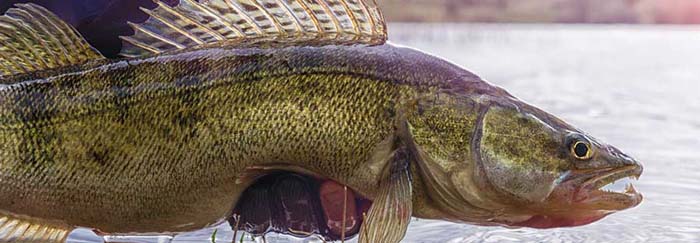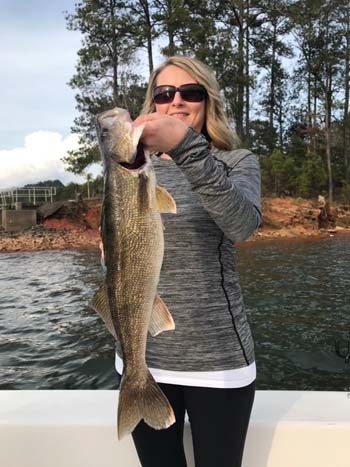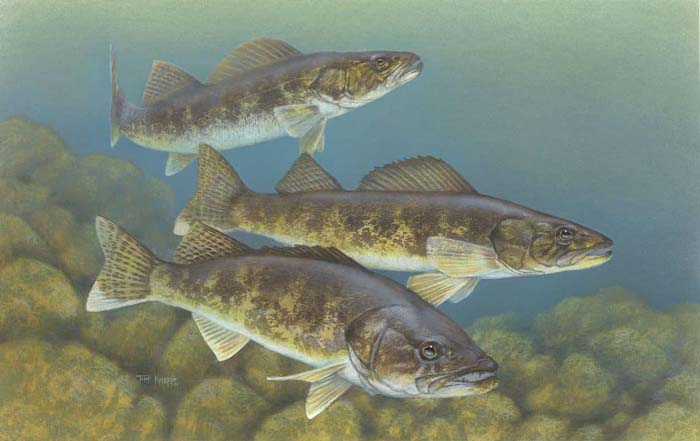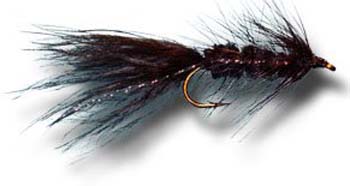
The walleye (Sander vitreus) is a freshwater perciform fish native to most of Canada and the Northern United States. IGFA World Record on a Fly is 22-pounds – Michigan in 1999. Above pictured walleye from Lake Erie. Photo Michigan Department of Natural Resources.
Can fly fishing for walleye deeper than 20-feet be worth it?
By Skip Clement
[dropcap]O[/dropcap]ne of my first passions for fly fishing was walleye on a lake in northwest Ontario. We fished it for two years. The guides were all indigenous peoples that knew where the walleye hung out and to start fishing a few hours before sunset and a few hours into the night… or longer. Walleye have established habits:

Walleye, a native of Canada and northern US is very much a part of the Southeast and the West as transplants. Photo taken Lake Carter by Georgia DNR – a commons image.
1. Walleye are not bottom feeders or a look-down species, but they always hang on or near the bottom using structure (humps and saddles), like rock formations and attack chance passerby baitfish. At midday it’s going to be more challenging to catch walleye – they do not like sunlight. They will come near the surface on cloudy days, pre-dawn and pre-sundown and into the night. Usually 8-to 20-feet.
2. During the first full moon in June, mayfly (big hex) hatches will come to the surface, and so will everything else in the lake. This phenomenon is usually a short-lived event.
3. Schoolie walleye are small juvenile fish (to 18 +/- inches) that school-up en masse, generally around structure. Finding them is what it’s all about – local knowledge paramount. Catch one, stay where you are, like dolphinfish they’ll hang around, and it’s a great scrum – you and the walleyes.
4. Walleye prefer night feeding, and the one-offs (10-pounders) are the deeper dwellers, but in low light forage in shallower water, 5- to 20-feet.
Equipage:
Fly rod – 6- thru 8-weight
Fly line – sinking.
Leader – Fluorocarbon leaders (12- to 16-pound with a bite guard or shock tippet). Keep the leader short, 3- to 5-feet long and bounce the fly off the bottom, then with floatant maneuvering the fly upward “slowly” purge the bottom. Hint: If you think you’re moving too slowly, slow down even more.
The best move is strip 3- to 4-inches, stop for a few seconds, and repeat. The big walleye will “usually” hit on the pause.

Walleye (Painting by Timothy Knepp, U.S. Fish and Wildlife Service) – a commons image.
If a 10-pound walleye (30+ inches) is “fish-on,” you want it on the reel ASAP. It will take you to structure and break you off. If you get it away from rocks and it surfaces, it will jump and run into your backing with a 6- to 8-weight fly rod.
Flies – Black or black… baitfish, Woolly Bugger, leeches and use more prominent and swishy material tails like good marabou and pine squirrel tail. Think silhouetted.

Black Wooly Bugger will serve you well – bring lots and a lots of floatant.
Retrieve – Use any fly, but apply floatant liberally on it, so that it sits as high up in the water as the leader allows. The idea is that a retrieve will pull it down, and the pause lets it rise. The later is when you’ll get a strike from “bigger” walleye.
Smaller schoolies are in a much more competitive situation, and a normal retrieve will invite strikes

